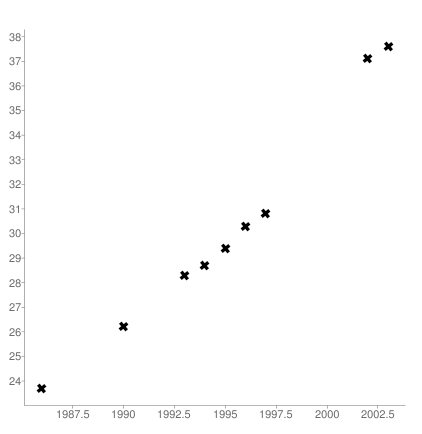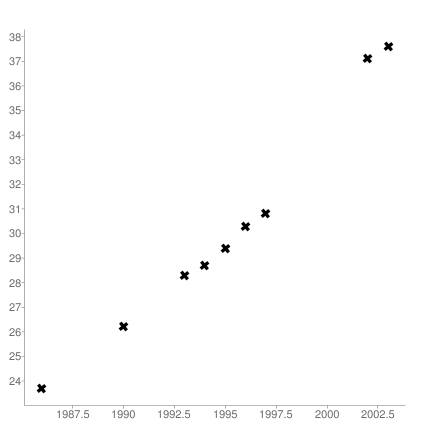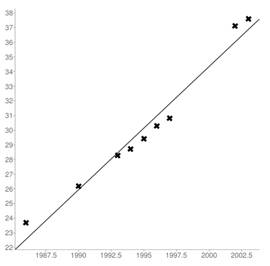
Concept explainers
a.
To graph: the data on the
a.
Answer to Problem 10E

Explanation of Solution
Given information:
The table of values given is as follows:
| Year (x) | Percentage of women in Professional Jobs (y) |
| 1986 | 23.7 |
| 1990 | 26.2 |
| 1993 | 28.3 |
| 1994 | 28.7 |
| 1995 | 29.4 |
| 1996 | 30.3 |
| 1997 | 30.8 |
| 2002 | 37.1 |
| 2003 | 37.6 |
| 2008 | ? |
Calculation:
The graph for the given data is shown below.

b.
To find: best fit line using two ordered pairs.
b.
Answer to Problem 10E
Explanation of Solution
Given information:
The table of values given is as follows:
| Year (x) | Percentage of women in Professional Jobs (y) |
| 1986 | 23.7 |
| 1990 | 26.2 |
| 1993 | 28.3 |
| 1994 | 28.7 |
| 1995 | 29.4 |
| 1996 | 30.3 |
| 1997 | 30.8 |
| 2002 | 37.1 |
| 2003 | 37.6 |
| 2008 | ? |
Calculation:
Let’s select any two ordered pair like
Now, plug the value of m and any one point coordinate into the slope intercept equation and evaluate b as follows:
Now, plug the values of m and b in the slope intercept formula as follows:
Thus, the line equation is
c.
To find: the equation for
c.
Answer to Problem 10E
Explanation of Solution
Given information:
The table of values given is as follows:
| Year (x) | Percentage of women in Professional Jobs (y) |
| 1986 | 23.7 |
| 1990 | 26.2 |
| 1993 | 28.3 |
| 1994 | 28.7 |
| 1995 | 29.4 |
| 1996 | 30.3 |
| 1997 | 30.8 |
| 2002 | 37.1 |
| 2003 | 37.6 |
| 2008 | ? |
Calculation:
The graph for the above equation is as follows:

Using the graphing calculator, the regression line equation is as follows:
Using the graphing calculator, the
d.
To find: the missing value if regression line equation has strong or moderate relationship, and explains whether the prediction is reliable.
d.
Answer to Problem 10E
Prediction is unreliable.
Explanation of Solution
Given information:
The table of values given is as follows:
| Year (x) | Percentage of women in Professional Jobs (y) |
| 1986 | 23.7 |
| 1990 | 26.2 |
| 1993 | 28.3 |
| 1994 | 28.7 |
| 1995 | 29.4 |
| 1996 | 30.3 |
| 1997 | 30.8 |
| 2002 | 37.1 |
| 2003 | 37.6 |
| 2008 | ? |
Calculation:
The equation of regression line shows strong relationship because
Plugging
If 100% or more than that hold professional job, then there will be no women working for minimum wages. Only men will be working doing low wages jobs. The another possibility is that less and less women will hold jobs over the years. Unemployment will skyrocket and the few women who still have jobs, have managerial or professional jobs.
But this still doesn't account for the fact that the percentage will be larger than 100 fairly quickly. The regression line is completely unreliable, so any predictions made from it are also unreliable.
Chapter 1 Solutions
Advanced Mathematical Concepts: Precalculus with Applications, Student Edition
Additional Math Textbook Solutions
Calculus: Early Transcendentals (2nd Edition)
University Calculus: Early Transcendentals (4th Edition)
Elementary Statistics (13th Edition)
Thinking Mathematically (6th Edition)
A First Course in Probability (10th Edition)
- Please as many detarrow_forward8–23. Sketching vector fields Sketch the following vector fieldsarrow_forward25-30. Normal and tangential components For the vector field F and curve C, complete the following: a. Determine the points (if any) along the curve C at which the vector field F is tangent to C. b. Determine the points (if any) along the curve C at which the vector field F is normal to C. c. Sketch C and a few representative vectors of F on C. 25. F = (2½³, 0); c = {(x, y); y − x² = 1} 26. F = x (23 - 212) ; C = {(x, y); y = x² = 1}) , 2 27. F(x, y); C = {(x, y): x² + y² = 4} 28. F = (y, x); C = {(x, y): x² + y² = 1} 29. F = (x, y); C = 30. F = (y, x); C = {(x, y): x = 1} {(x, y): x² + y² = 1}arrow_forward
- ٣/١ B msl kd 180 Ka, Sin (1) I sin () sin(30) Sin (30) اذا ميريد شرح الكتب بس 0 بالفراغ 3) Cos (30) 0.866 4) Rotating 5) Synchronous speed, 120 x 50 G 5005 1000 s = 1000-950 Copper bosses 5kW Rotor input 5 0.05 : loo kw 6) 1 /0001 ined sove in peaper I need a detailed solution on paper please وه اذا ميريد شرح الكتب فقط ١٥٠ DC 7) rotor a ' (y+xlny + xe*)dx + (xsiny + xlnx + dy = 0. Q1// Find the solution of: ( 357arrow_forward۳/۱ R₂ = X2 2) slots per pole per phase 3/31 B. 180 msl Kas Sin (I) 1sin() sin(30) Sin (30) اذا ميريد شرح الكتب بس 0 بالفراغ 3) Cos (30): 0.866 4) Rotating 5) Synchronous speeds 120×50 looo G 1000-950 1000 Copper losses 5kw Rotor input 5 loo kw 0.05 6) 1 اذا ميريد شرح الكتب فقط look 7) rotor DC ined sove in peaper I need a detailed solution on paper please 0 64 Find the general solution of the following equations: QI//y(4)-16y= 0. Find the general solution of the following equations: Q2ll yll-4y/ +13y=esinx.arrow_forwardR₂ = X2 2) slots per pole per phase = 3/31 B-180 60 msl kd Kas Sin () 2 I sin (6) sin(30) Sin (30) اذا مريد شرح الكتب بس 0 بالفراغ 3 Cos (30) 0.866 4) Rotating ined sove in peaper 5) Synchronous speed s 120×50 6 s = 1000-950 1000 Copper losses 5kw Rotor input 5 0.05 6) 1 loo kw اذا ميريد شرح الكتب فقط Look 7) rotov DC I need a detailed solution on paper please 0 64 Solve the following equations: 0 Q1// Find the solution of: ( y • with y(0) = 1. dx x²+y²arrow_forward
- R₂ = X2 2) slots per pole per phase = 3/3 1 B-180-60 msl Ka Sin (1) Isin () sin(30) Sin (30) اذا ميريد شرح الكتب بس 0 بالفراغ 3) Cos (30) 0.866 4) Rotating 5) Synchronous speed, 120 x 50 s = 1000-950 1000 Copper losses 5kw Rotor input 5 6) 1 0.05 G 50105 loo kw اذا ميريد شرح الكتب فقط look 7) rotov DC ined sove in peaper I need a detailed solution on paper please 064 2- A hot ball (D=15 cm ) is cooled by forced air T.-30°C, the rate of heat transfer from the ball is 460.86 W. Take for the air -0.025 Wim °C and Nu=144.89, find the ball surface temperature a) 300 °C 16 b) 327 °C c) 376 °C d) None か = 750 01arrow_forwardDon't do 14. Please solve 19arrow_forwardPlease solve 14 and 15arrow_forward
- 1. Consider the following system of equations: x13x2 + 4x3 - 5x4 = 7 -2x13x2 + x3 - 6x4 = 7 x16x213x3 - 21x4 = 28 a) Solve the system. Write your solution in parametric and vector form. b) What is a geometric description of the solution. 7 c) Is v = 7 in the span of the set S= [28. 1 HE 3 -5 3 ·6 ? If it is, write v 6 as a linear combination of the vectors in S. Justify. d) How many solutions are there to the associated homogeneous system for the system above? Justify. e) Let A be the coefficient matrix from the system above. Find the set of all solutions to Ax = 0. f) Is there a solution to Ax=b for all b in R³? Justify.arrow_forward4. Suppose that A is made up of 5 column vectors in R³, and suppose that the rank(A)=3. a. How many solutions are there to Ax=0? Justify. b. What is a geometric description for the nullspace(A)? Justify. c. Do the column vectors of A span R³? Justify. d. Is A invertible? Justify.arrow_forward3. Suppose that A is 5 x 5 and rank(A)=4. Use this information to answer the following. a. Give a geometric description of nullspace(A). Justify. b. Is A invertible? Justify. c. Give a geometric description of the span of the column vectors of A. What space are the column vectors of A in? Justify. d. What is determinant of A? Justify.arrow_forward
 Calculus: Early TranscendentalsCalculusISBN:9781285741550Author:James StewartPublisher:Cengage Learning
Calculus: Early TranscendentalsCalculusISBN:9781285741550Author:James StewartPublisher:Cengage Learning Thomas' Calculus (14th Edition)CalculusISBN:9780134438986Author:Joel R. Hass, Christopher E. Heil, Maurice D. WeirPublisher:PEARSON
Thomas' Calculus (14th Edition)CalculusISBN:9780134438986Author:Joel R. Hass, Christopher E. Heil, Maurice D. WeirPublisher:PEARSON Calculus: Early Transcendentals (3rd Edition)CalculusISBN:9780134763644Author:William L. Briggs, Lyle Cochran, Bernard Gillett, Eric SchulzPublisher:PEARSON
Calculus: Early Transcendentals (3rd Edition)CalculusISBN:9780134763644Author:William L. Briggs, Lyle Cochran, Bernard Gillett, Eric SchulzPublisher:PEARSON Calculus: Early TranscendentalsCalculusISBN:9781319050740Author:Jon Rogawski, Colin Adams, Robert FranzosaPublisher:W. H. Freeman
Calculus: Early TranscendentalsCalculusISBN:9781319050740Author:Jon Rogawski, Colin Adams, Robert FranzosaPublisher:W. H. Freeman
 Calculus: Early Transcendental FunctionsCalculusISBN:9781337552516Author:Ron Larson, Bruce H. EdwardsPublisher:Cengage Learning
Calculus: Early Transcendental FunctionsCalculusISBN:9781337552516Author:Ron Larson, Bruce H. EdwardsPublisher:Cengage Learning





